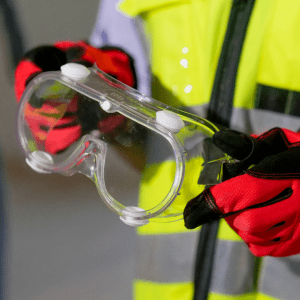Eye Safety in the Workplace

Workers avoid utilizing protective eyewear for many reasons. Employees may think they aren’t necessary, glasses or goggles aren’t comfortable, or they have to stop to readjust safety eyewear. However, the Occupational Safety and Health Administration (OSHA) declares the lack of required eye and face protection as one of its top ten cited workplace violations. And, OSHA reports 90% of eye-related incidents could be avoided simply by wearing eye protection and observing additional safety practices. For workplace eye safety, we’ve summed up the following hazards, safety tips, employer responsibilities, and ways to protect your eyes.
Common Workplace Eye Hazards
- Chemical – Splashes and fumes from harsh chemicals can be devastating to the eyes at work.
- Blood/Bodily fluid – Disease can be spread by blood, mucus, and other bodily fluids entering the eyes.
- Projectiles – Wood, metal, concrete, and other fragments can penetrate the eyes, causing considerable damage.
- Harmful radiation – Welding arcs, ultraviolet radiation, and lasers can burn the cornea.
Eye injuries can occur unexpectedly, but extra care should be taken while working around these threats.
Protect Your Eyes
- Safety goggles/glasses – Protective eyewear protects from chemical splashes, dust, and impact from projectiles. Glasses can be combined with side shields to protect the sides of your eyes as well.
- Face shields and helmets – These offer protection from chemicals, heat, and blood-borne pathogens. Face shields should be combined with safety glasses or goggles to protect the eyes when the shield is lifted. Special-purpose face shields/helmets should be used when welding, handling fiber optics, and lasers.
- Inspect and maintain the condition of your eyewear – Be sure to clean and examine your eyewear after each use and replace it if damaged. Make sure to remove dust and objects from hair, hats, and clothing before removing eyewear.
You are the greatest resource in protecting your eye health. Understand and be aware of the specific job conditions that pose a threat to your eye safety and act accordingly.
Employer Responsibility
- Safety-rated, impact-resistant eyewear should be accessible to each employee.
- Training in the proper use of eyewear and headgear, along with first-aid kits and eye wash stations should be available to all staff and customers.
- Employers should conduct a hazard assessment to determine the appropriate eyewear for a specific task and area.
- The installation of shields in areas prone to flying debris is necessary to protect employees.
First Aid for Eye Injuries
Chemical and thermal burns
Remove contact lenses, if possible, before flushing eyes. Flush eyes for at least 15 minutes.
Particles
Do not rub your eyes as this may cause further damage. Irrigate your eyes with artificial tears or let your natural tears wash out the foreign substance. If the particle does not wash out, seek medical attention.
Cuts and punctures
Do not attempt to remove an object that has pierced your eye. Do not wash the eye. Cover the eye with an eye shield. Seek medical care.
Blows to the eye
Gently apply a cold compress. Medical treatment should be sought for severe pain and reduced vision.
Take every precaution to avoid eye trauma and ensure eye safety in the workplace . When in a work environment that can be harmful to your eye health, it is wise to never enter that space without proper protective equipment including personal protective eyewear or full face respirators. If an injury occurs seek out immediate first aid and professional medical attention.
Regular eye exams are important if you want to ensure good vision to safely perform tasks on your job. Please contact The Eye Center, with locations in Huntsville and Madison, at (256)705-3937 to schedule a comprehensive eye exam.
